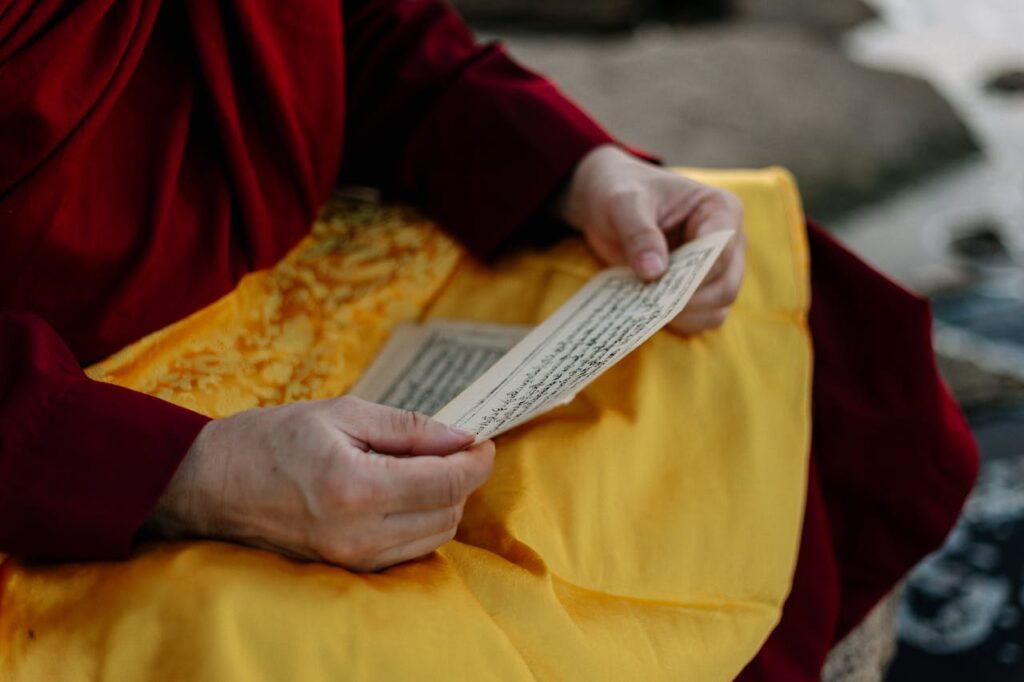A mantra is a word, phrase, sound, or syllable that is repeated either silently or aloud as part of a meditation or spiritual practice. Mantras are often used in various religious and spiritual traditions, including Hinduism, Buddhism, Sikhism, and Jainism, as well as in secular mindfulness and meditation practices. The word “mantra” itself is derived from Sanskrit and consists of two parts: “man,” which means “mind,” and “tra,” which means “tool” or “instrument.” Therefore, a mantra is often considered a tool for the mind.
The repetition of a mantra is believed to have several purposes and benefits, including:
1. Focusing the mind: Mantras help individuals concentrate their thoughts and quiet the mind, making it easier to enter a meditative state.
2. Creating positive vibrations: The sound and resonance of the mantra are thought to create positive energy and a sense of tranquility.
3. Aiding in self-transformation: Mantras can be used to cultivate specific qualities or virtues, such as love, compassion, patience, or inner peace.
4. Spiritual connection: Mantras are sometimes associated with specific deities or spiritual principles and are used to establish a connection with them.
5. Stress reduction: Repetition of a mantra can be a form of stress relief and relaxation.
In Hinduism and Buddhism, specific mantras are associated with particular deities or aspects of the divine, and they are often passed down through oral tradition. For example, the “Om” mantra is considered a universal and highly revered mantra in both of these traditions.
In mindfulness and secular meditation practices, mantras are often used as a way to anchor one’s attention and maintain mindfulness. In this context, the mantra might be a simple word or phrase that has personal significance or is chosen for its calming and centering effect.
Overall, mantras are versatile tools that can be adapted to various spiritual, mental, and emotional needs, and their use can vary widely across different cultures and belief systems.
The evolution of mantras can be traced back to ancient Vedic traditions in India, where they were initially composed as sacred sounds and verses for use in rituals, ceremonies, and religious practices. These early mantras were often chanted or sung as part of offerings to deities, meditation, and other spiritual activities. Over time, the concept and usage of mantras evolved and spread to various religious and philosophical traditions, each with its own interpretations and purposes.
Mantras, in their most basic form, are typically shorter and consist of a single word, a short phrase, or a syllable. They are designed for repeated chanting or meditation and are often used to focus the mind, invoke specific energies or deities, and promote inner transformation. They are considered a means of connecting with the divine and accessing spiritual wisdom.
On the other hand, a stotra is a form of devotional hymn or song in praise of a deity or a divine aspect. Stotras are generally longer and more elaborative than mantras, often featuring descriptive and reverential verses that extol the virtues, qualities, and attributes of the deity. Stotras are typically used for devotion, expressing reverence, and seeking the blessings or grace of the divine. They are recited or sung in a melodious manner as a form of worship.
The significance of mantras and stotras varies based on their usage and purpose:
1. Mantras:
– Mantras are typically shorter and more concise, designed for repetition and meditation.
– They are often used for achieving mental focus, calming the mind, and attaining inner peace.
– Mantras can be associated with specific intentions or qualities, and their repetition is believed to bring about personal transformation.
– Mantras may be used in meditation, yoga, and other spiritual practices to aid in achieving altered states of consciousness and spiritual realization.
2. Stotras:
– Stotras are longer and more expressive, often comprising verses that eulogize and praise a deity or divine principle.
– They are typically used in devotional practices to express love, gratitude, and reverence toward the divine.
– Stotras serve as a means of seeking blessings, protection, and divine intervention.
– Stotras are commonly recited during religious ceremonies, rituals, and prayer as a form of devotion.
In essence, while both mantras and stotras are integral to many spiritual and religious traditions, they serve different functions. Mantras are often used for meditation, personal transformation, and inner realization, while stotras are primarily used for devotion and expressing reverence and gratitude to the divine. The choice of whether to use a mantra or a stotra depends on one’s spiritual objectives and the context in which they are being employed.
The Author Dr.Sowmya is a physician and yogic practitioner. She has her Mantra Podcast Channel.
Offers Illuminate : The Path Within
Suggested Reading Meditation

